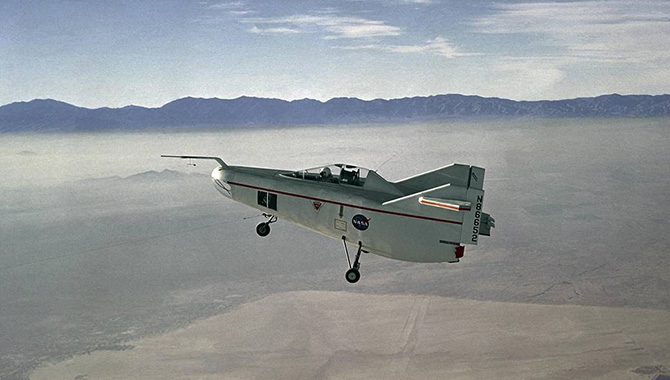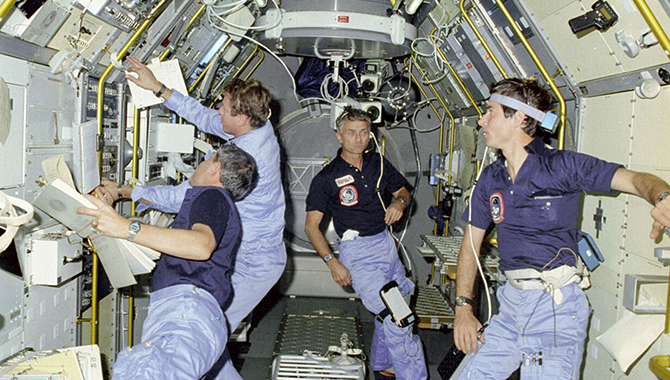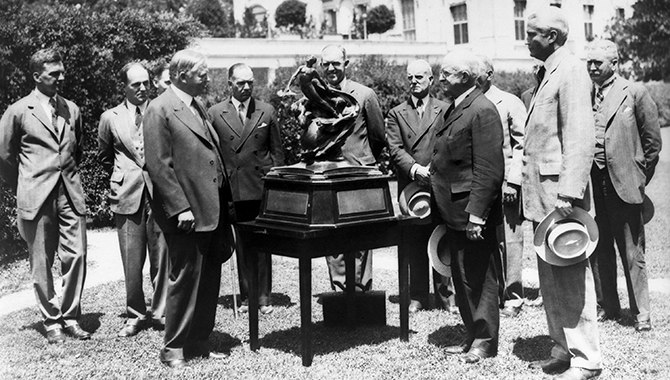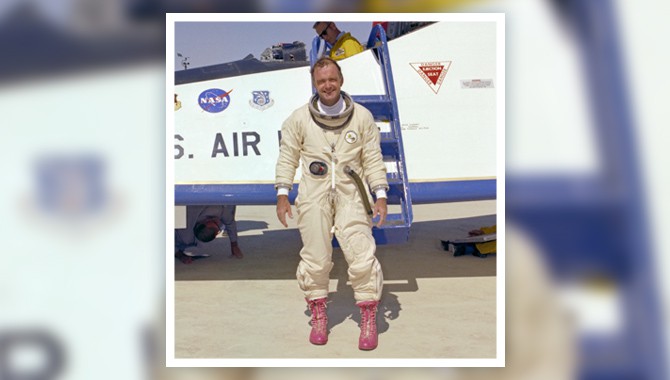
NASA pilot Bill Dana steps away from the final powered flight of the lifting body program on September 23, 1975, wearing his infamous pink boots.
Photo Credit: NASA
Forty years ago this month, William “Bill” Dana piloted the final rocket-powered flight of the joint NASA-U.S. Air Force lifting body program.
The X-24B was the last aircraft in the lifting body program that ran from 1963 to 1975 at NASA’s Flight Research Center (later Dryden Flight Research Center, now Armstrong Flight Research Center). The program—and, in particular, precision landings made by the X-24B onto a runway at Edwards Air Force Base—established that a wingless spacecraft could reenter Earth’s atmosphere and land safely and accurately without an air-breathing engine. This information proved crucial to the design of the space shuttle, confirming once and for all that the orbiter did not need to shoulder the extra cost and weight of jet engines and their fuel. Instead, the shuttle could allocate that weight to larger payloads, enhancing the scientific value of its missions.
The lifting body program that informed space shuttle design consisted of six wingless space vehicles. Called “lifting bodies” because they generated lift from their fuselage design, they performed well at high speeds. Their ability to remain stable at subsonic speeds, however, was less certain. So the program focused on the final stages of atmospheric reentry through touchdown to assess whether a wingless craft could land safely without power.
Only a single prototype of each lifting body design was built. The first was the unpowered M2-F1, which was towed—initially behind a souped-up Pontiac convertible, later behind a small plane—before gliding down to its landing. Considered a success, two designs followed: the M2-F2 and the HL-10. Unlike the original lifting body, the two new space planes featured full-thrust rocket engines that enabled high-speed flight tests. All five of the powered lifting bodies used XLR-11 rocket engines—the same four-chamber engine that had powered the Bell X-1, the first plane to break the sound barrier—found in museums and restored to working order.
The M2-F2, which was later modified and rebuilt as the M2-F3, and the HL-10 were developed for NASA. At the same time, the Air Force was investigating lifting bodies following the conclusion of the X-20 Dyna-Soar program. They commissioned Martin Marietta to design the X-24A. This potato-shaped vehicle was able to land, unpowered, on the same dry lakebed its predecessors had used. But it lacked the degree of stability required for a runway landing, a goal not yet achieved by any of the lifting bodies. The X-24A flew 28 times before the Air Force decided to redesign and rebuild it.
The resulting research plane was the X-24B. With its rounded top, flat bottom, and pointed nose, it looked more like an iron used to press clothes than like the bulbous lifting bodies that had gone before. Its unique design and double-delta wing shape provided twice as many lifting surfaces as on the X-24A. As a result, the vehicle gained the stability needed to land at lower speeds, which in turn enabled greater precision for touchdown.
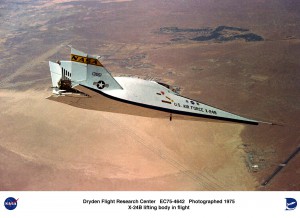
The X-24B, the last aircraft to fly in the NASA-Air Force lifting body program, is seen here in flight above Rogers Dry Lake.
Photo Credit: NASA
The first flight of the X-24B, on August 1, 1973, was unpowered. Like all the lifting bodies, it was carried up to 45,000 feet under the wing of a modified B-52: the same vehicle that had been used years earlier for the X-15 rocket plane program. It glided down to land on the dry lakebed. Three months later, the X-24B took its first powered flight. As it was air launched from beneath the wing of the bomber, the pilot lit the XLR-11 and the craft shot forward. Once the engine stopped, the X-24B glided down toward Edwards Air Force Base. The pilot, John Manke, maintained a careful balance of adequate speed to reach the desired site tempered by a series of turns designed to slow the aircraft satisfactorily for landing.
Ultimately, the X-24B flew 12 glide flights and 24 powered ones. It achieved speeds of more than 1,000 miles per hour and altitudes above 74,000 feet. But the focus of the program was on landing, and that is where the X-24B stood out. In August of 1975, the X-24B twice landed on a concrete runway at Edwards Air Force Base, a feat no other vehicle in the program had accomplished.
The last powered flight of the X-24B took place on September 23, 1975. At the controls was NASA research pilot Dana, who had also helmed the final flight of the X-15 years earlier. Dana was a 10-year veteran of the lifting body program, having flown four of the vehicles for a total of 31 flights. In 1976 he was awarded the NASA Exceptional Service Medal in recognition of his decade with the program. The same year he also received the American Institute of Aeronautics and Astronautics’ Haley Space Flight Award for his extensive work on the M2-F3 control systems.
By the time Dana sat in the cockpit on September 23, he’d already piloted the M2-F1, the HL-10, the M2-F3, and the X-24B. During the HL-10 project, the pressure suit worn by the pilots was redesigned and the new white suit was issued with white boots. Dana wasn’t thrilled by the shift in color from black boots to white and stated that they might as well be pink. David Clark Co., which had developed the suits, delivered a pair of black boots to Dana—accompanied by a pair of pink ones, with daisy decals, as a joke.
Dana wore those pink boots on his last flight in the X-24B. The flight proceeded almost as planned: the B-52 took Dana and the X-24B up to altitude and dropped the plane. But when Dana flipped the engine switch, only three chambers ignited. Fortunately, he had trained for this possibility in the simulator and followed a modified flight plan back to base, where he landed on Rogers Dry Lake.
That flight represented the final rocket-powered lifting body mission. It was also the last rocket plane launched out of Dryden and marked the retirement of the XLR-11 engine. The X-24B program continued briefly with a few more glide flights before closing its doors on November 26, 1975. The aircraft is now on display at the Air Force Museum at Wright-Patterson Air Force Base in Ohio.
Dana went on to become Chief Engineer at Dryden from 1993-1998, when he retired. In 2005, he and two other NASA pilots—Joe Walker and John “Jack” McKay—were awarded astronaut wings for their X-15 flights that exceeded 50 miles in altitude. The lifting body program was recognized in a different way: each time the space shuttle landed on a runway, the contributions of those wingless vehicles were clear.
Watch a video of the X-24B landing on the runway at Edwards Air Force Base.
See the X-24B get air launched from beneath the wing of a B-52.






